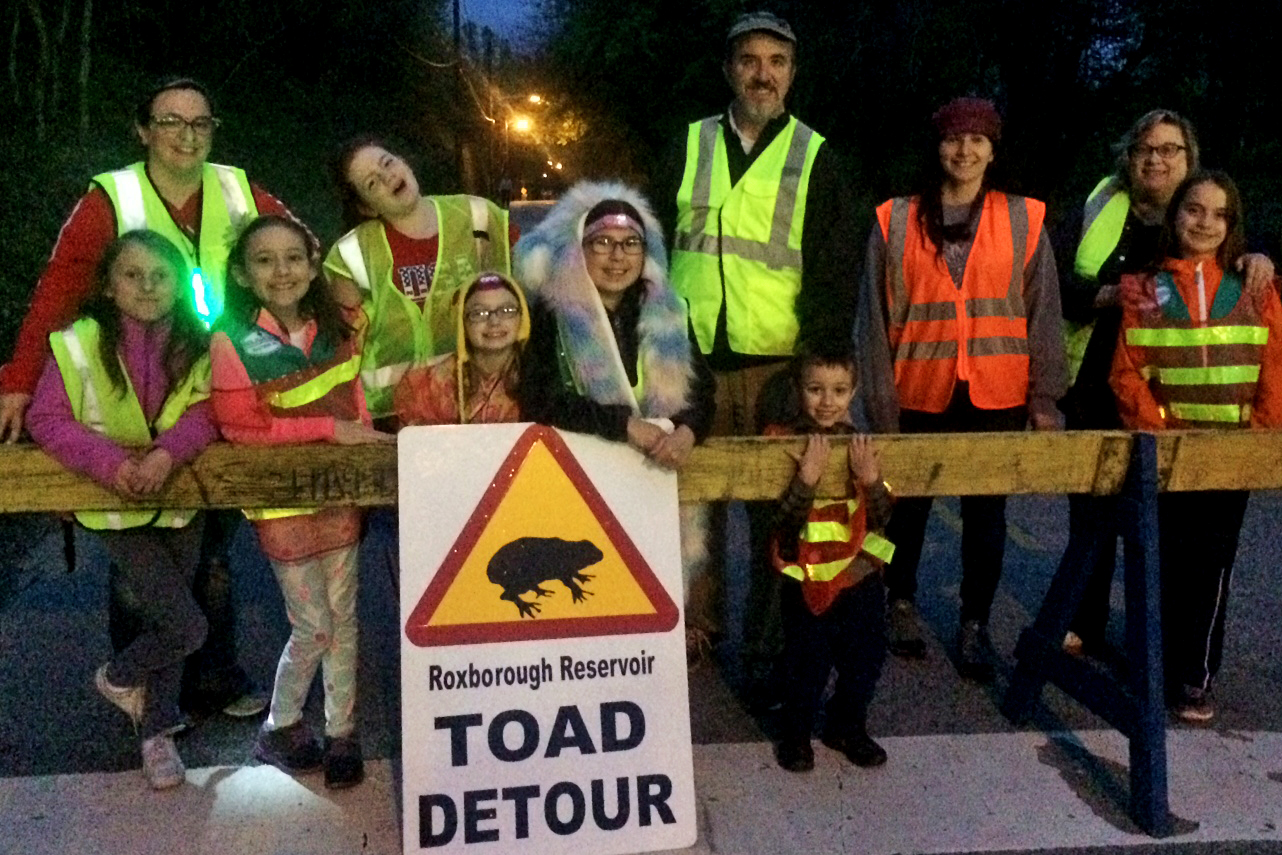After managing the Toad Detour in Roxborough every spring for nine years, volunteers know why the toads cross the road, but it’s harder to predict when.
Last year, says Schuylkill Center for Environmental Education volunteer coordinator Claire Morgan, volunteers spotted one toad on March 1, which is the first day the group’s Philadelphia Police Department traffic-blocking permit is valid. Then, a late snowstorm hit and the rest of the toads stayed put for a few more weeks.
But at the start of toad season, volunteers are ready to move when the amphibians do.
The original Toad Detour founder, Lisa Levinson, first noticed the problem in 2009. Driving along a road that borders the old Roxborough reservoir, she realized that passing cars were squashing hundreds of toads as they hopped toward the water. She organized a group who were the first to guard the roads bordering the reservoir. A few years later, the nearby Schuylkill Center for Environmental Education formally adopted the program, and this will be Morgan’s seventh year managing it.
“This is such a unique situation,” she says. There are other groups around the country and even around the world who help migrating toads cross the road, but these are usually rural efforts. This is a mass movement of animals inside Philadelphia’s city limits.
So why do the toads cross the road?
The toads (and some frog friends) spend the winter hibernating deep in the ground in the 340 acres of protected woods belonging to the Schuylkill Center, and adjacent land. Then, when the weather warms up in March, the toads wake up, dig their way out, and hop en mass to the abandoned reservoir, where they mate and lay their eggs before returning to the woods. (Go to help out yourself, and on a busy night, there are so many marching toads that the woods rustle.)
Their eggs hatch and their tadpoles grow. Then, in May or June, the second wave of the migration starts when the tiny toadlets (who could fit on your little fingernail) come out of the water, cross the road, and start life in the woods.
The toads do what they’re meant to: get to water to reproduce. They don’t realize a busy human roadway lies between them and their destination. There are plenty of reasons we should lend a hand. For many toad helpers, it’s hard not to love the determined little animals in their pebbled brown skins for their own sake, but they’re also an important part of the local ecosystem (one thing humans can be grateful for is the toads’ appetite for mosquitos). And as an expert at the Philadelphia Zoo told me last year in this story on animal conservation for Keystone Edge, amphibians perform a function that no other animal does. Their unique life cycle passes important nutrients between land and water ecosystems that could not arrive any other way.
During the two migrations, Toad Detour volunteers of all ages don reflective vests and set up signs and road barricades. Without handling the toads unnecessarily, their goal is to redirect cars between the high-traffic hours of 7 – 9pm, which is also when the toads like to move.
These citizen scientists carry clipboards to count the toads they spot, letting the Schuylkill Center track data year to year. It’s not an easy job, because damp weather is the toads’ favorite. As long as there’s no lightning, volunteers work through the spring rain. The Schuylkill Center has an easy online portal to sign up, and volunteer organizers lead each evening’s detour (the Center is especially looking for volunteers able to fill this leadership role). The toads don’t move every night. Sometimes it’s too dry, or too cold. Volunteers wait and watch the weather before coming out.
Now that the Toad Detour is celebrating its 10th anniversary year, “We can document that we’ve crossed at least 12,000 adult toads,” Morgan says. The numbers vary by year. 2014 set the record, with 2,400 adult toads counted; last year, there were 700 (though Morgan notes that these are only the toads counted between 7 – 9pm; others may cross later after traffic dies down and the volunteers go home).
“And who knows how many toadlets,” Morgan adds. “They’re impossible to count.” Given that each female toad lays between 4,000 and 20,000 eggs, the babies could number in the millions.

Last year, the Schuylkill Center launched a special program for local girl scouts, who attended a training session and then volunteered on three nights to earn a Toad Detour badge. That program continues this year, with training slated for April 17. Older kids help out too, with several Philly-area high schools volunteering for their community service.
And the drivers who have to go around for the sake of the toads? Some get annoyed, but as the years pass and awareness increases, locals adjust.
“In the last few years, there have been fewer angry people,” Morgan says. Instead of being angry at the barricade, people say, “‘Oh great, are the toads moving?’ And they go around the block.”

